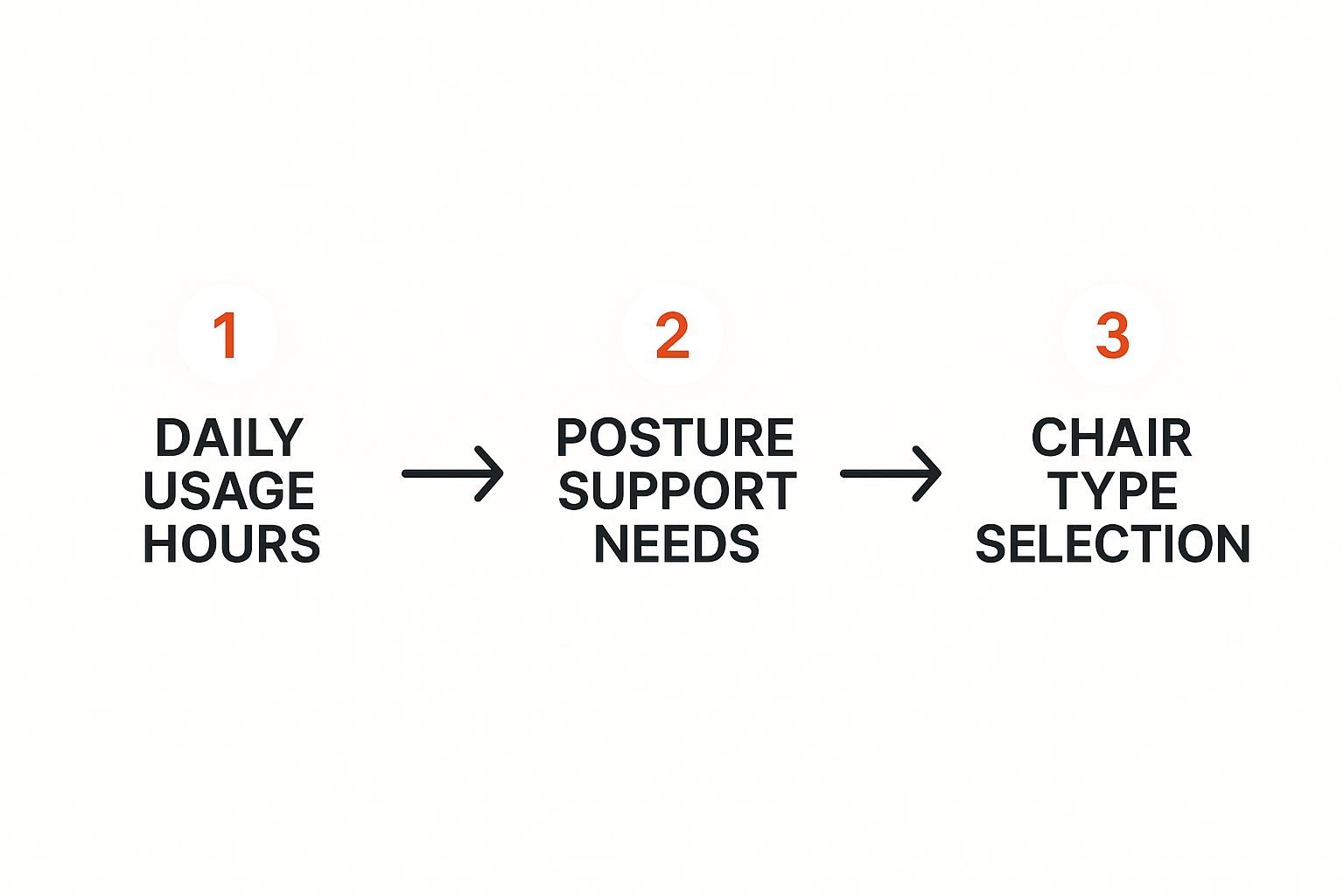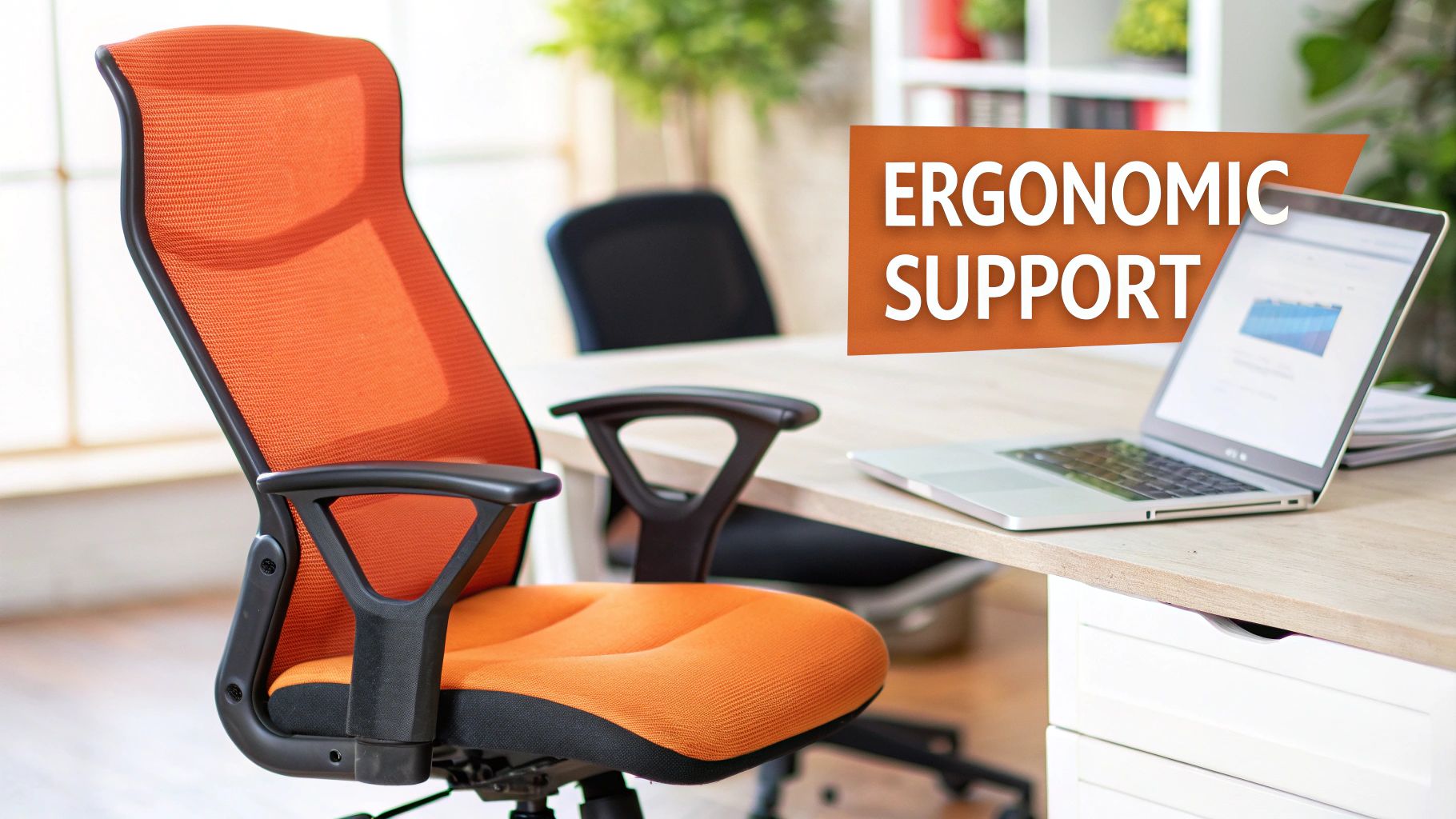Choosing the right desk chair isn't as complicated as it seems. It's really about matching the chair's features—like adjustable lumbar support, seat depth, and armrests—to your unique body shape and how you work. The ultimate goal is to find a chair that encourages a healthy, neutral posture, which makes all the difference for staying comfortable and focused through a long day.
Why Your Desk Chair Is a Critical Investment
It’s easy to think of a desk chair as just another piece of office furniture, but that's a huge mistake. Honestly, it’s one of the most important tools you'll buy, directly impacting your health, productivity, and overall wellbeing every single day. The wrong chair can be the sneaky culprit behind that nagging back pain, stiff neck, or even why you find it so hard to concentrate in the afternoon.
This goes way beyond just feeling comfortable. A truly supportive chair is a long-term investment in your physical health. When your body is properly aligned, you significantly lower the risk of developing chronic musculoskeletal problems that can follow you for years. It’s the difference between clocking off feeling energised or completely wiped out.
The Growing Demand for Better Chairs
With the huge shift to flexible and remote work, we've all become much more aware of how crucial proper ergonomic setups are. As more of us create home offices, the demand for high-quality, adaptable furniture has exploded.
You can see this trend right across the industry. The Australian office furniture market, which of course includes desk chairs, has already grown to over USD 2 billion and is expected to keep climbing. This isn't just a number; it shows a real shift in mindset. Both companies and individuals are finally realising that a comfortable, adaptable workspace is non-negotiable for productivity.
A good desk chair is the cornerstone of a functional workspace. For more ideas on creating an optimal office environment, these essential office renovation tips offer some great insights.
What to Prioritise in Your Search
To make a smart choice, you need to know what separates a genuinely great chair from a mediocre one. I'll walk you through everything you need to consider so you can feel confident in your decision.
The single most important rule when choosing a desk chair is this: the chair must adapt to you, not the other way around. Prioritise adjustability above everything else—it's the only way to get personalised comfort and support.
Here’s a quick rundown of what we’ll cover to help you find that perfect chair:
- Ergonomics and Adjustability: We'll break down what features like lumbar support, seat depth, and 4D armrests actually mean for your body and posture.
- Materials and Durability: You'll learn what to look for in a chair's build, from breathable mesh backs to robust steel bases that are made to last.
- Budget and Warranty: We'll explore what you can expect at different price points and why a solid warranty is a great indicator of a chair's quality.
Having a good grasp of these areas is your first step. For a deeper dive right away, our comprehensive office chair buying guide is a fantastic resource.
Key Ergonomic Features at a Glance
With so many features to consider, it's easy to feel a bit overwhelmed. This table breaks down the most critical ergonomic elements to look for, why they matter for your health, and what to keep an eye out for.
Think of this table as your checklist. If a chair you're considering ticks these boxes, you're on the right track to finding something that will genuinely support your body for years to come.
Decoding Chair Ergonomics and Adjustability
The word "ergonomic" gets tossed around a lot in chair descriptions, but what does it really mean for your body? It's more than just a marketing buzzword. A genuinely ergonomic chair is designed to move with you, adapting to your unique shape and the way you work, rather than locking you into a single, rigid posture.
Think of it like getting a tailored suit versus buying one off the rack. An ergonomic chair comes with a core set of adjustments that are non-negotiable if you want a proper fit. Without them, you’re essentially just guessing. Let’s get into what those critical adjustments are and, more importantly, how you can test them out for yourself.
The Foundation: Seat Height and Depth
Everything starts from the ground up. The most basic adjustment, seat height, is right when your feet are flat on the floor, your thighs are more or less parallel to it, and your knees form a 90-degree angle. This creates a solid foundation, helps with blood circulation, and stops you from either dangling your legs or perching on your toes.
Just as critical is the seat depth. To check this, sit all the way back until your lower back makes contact with the backrest. You should be able to slide about two to four fingers between the edge of the seat and the back of your knees.
If the seat is too deep, it’ll dig into your calves, which can cut off circulation and force you to slouch. If it’s too shallow, your thighs won't get enough support, leaving you feeling unstable and uncomfortable.
For taller people, a chair with a sliding seat pan can be a complete game-changer. It provides that essential thigh support that most standard chairs just can't offer.
Mastering Your Posture: Backrest and Lumbar Support
The backrest is where a chair truly earns its ergonomic stripes. It isn't just there for you to lean back on during a break; its main job is to support the natural S-curve of your spine. The feature you absolutely must look for here is adjustable lumbar support.
And I don't mean just a token cushion. A high-quality chair will let you move the lumbar support both up and down (vertically) and in and out (horizontally). This level of customisation ensures the support nestles perfectly into the curve of your lower back, preventing that all-too-common slouch that leads to back pain.
Along with the lumbar piece, look for a backrest recline with a tilt lock. A good chair should encourage you to move. Being able to recline and then lock that position lets you shift your posture throughout the day, which is vital for taking pressure off your spinal discs.
This simple chart shows how your daily work habits should inform the kind of support you need.

The main takeaway? Your daily routine dictates your postural needs, and that, in turn, points you to the right chair.
Understanding Armrest Adjustability
Armrests are so often an afterthought, but they do the heavy lifting when it comes to reducing strain on your neck and shoulders. The aim is to position them so your arms rest lightly on top, keeping your shoulders relaxed and not hunched up by your ears. This is where the different "D" levels of adjustability come into play:
- 2D Armrests: These adjust for height and width. This is the bare minimum you should accept, as it lets you set the armrests at the right level and distance from your body.
- 3D Armrests: These add forward and backward motion. This is brilliant for pulling the armrests back when you need to scoot closer to your desk, or for bringing them forward to support your forearms while typing.
- 4D Armrests: The gold standard. These add a pivoting motion (in and out), letting you angle the armrests to perfectly support your arms whether you're typing, using a mouse, or reading from a tablet.
While not everyone needs 4D armrests, having at least 2D adjustability is crucial for keeping upper body tension at bay. To see how all these features fit together, our guide goes into much more detail on what makes a chair ergonomic.
Of course, a great chair is only one piece of the puzzle. Real ergonomic comfort comes from your entire setup. Take some time to think about optimizing your entire workstation setup for ergonomics to create a workspace that truly supports you. When every element works in harmony, you'll absolutely feel the difference.
Looking at Materials and Long-Term Durability

So, you've figured out the adjustments you need. Now, let’s get into the feel and substance of the chair itself. The materials that make up the upholstery, frame, and base are what you'll be interacting with every day. They're what separate a chair that looks good on day one from one that still feels solid after years of use.
Getting this part right is about making a smart investment. After all, a chair is more than just a place to sit; it's a tool for your work.
Your Guide to Upholstery Choices
The surface you’re sitting on for hours at a time matters more than you might think. It directly impacts your comfort, how much cleaning is involved, and even how hot you get during a long afternoon.
When you start shopping, you’ll mainly find three options: mesh, fabric, and leather. Each has its own distinct personality, and the best one for you really comes down to your priorities and work environment.
Here’s a quick comparison to help you decide.
Chair Upholstery Comparison
Ultimately, there’s no single "best" material. If your office gets a bit stuffy, the breathability of a mesh chair is a lifesaver. But if you value a plusher, more cushioned experience and want more colour choices, a good fabric chair might be the better fit.
The Foundation: Understanding the Frame and Base
Don’t just look at what you sit on; look at what’s holding you up. A chair's frame and base are its skeleton, and they're responsible for keeping everything stable and secure. This is where you can quickly tell a well-built chair from a flimsy one.
Most chair bases are made from one of three common materials:
- Nylon (Plastic): You’ll find this on many entry-level chairs. It’s lightweight and gets the job done for standard office use, but it does have a lower weight capacity and can become brittle over time.
- Steel: A big jump in sturdiness. Steel bases are built to last and can handle heavy-duty, daily use without a problem. The only trade-off is the extra weight, which makes the chair a little harder to roll around.
- Polished Aluminium: This is the premium option, offering the perfect balance. It’s nearly as strong as steel but significantly lighter, providing a sleek look and fantastic longevity without the bulk.
A Pro Tip: The warranty tells you a lot about the manufacturer's confidence in their materials. A long warranty, especially one that covers the frame and mechanisms for 10 years or more, is a great sign of quality craftsmanship.
Making a More Sustainable Choice
These days, choosing office furniture is also an opportunity to think about our environmental impact. With Australia generating an estimated 8.5 million tonnes of furniture waste each year, there's a real push for more sustainable options.
To meet this demand, you’ll find many suppliers now offering chairs built with recycled metals, responsibly sourced wood, and even biodegradable plastics. If you're interested in market trends, you can read more about the shift in the Australian office furniture market.
When you’re comparing chairs, keep an eye out for these key certifications:
- GECA (Good Environmental Choice Australia): This label confirms the product meets high standards for environmental, health, and social responsibility.
- FSC (Forest Stewardship Council): If there are wood components, this tells you the timber comes from forests managed in a sustainable way.
Choosing a certified chair isn't just better for the planet. It often means you're getting a higher-quality product made with safer, low-VOC (volatile organic compound) materials, which is great for the air quality in your office or home.
For more practical advice on putting all these pieces together, our guide on finding the perfect ergonomic office chair has even more helpful tips.
A Practical Guide to Testing Your New Chair

Reading specifications and comparing features online will get you halfway there, but the real test of a desk chair happens when you actually sit in it. The most crucial part of choosing the right chair is the "test drive," whether you're in a showroom or taking advantage of a home trial.
This is your chance to see past the marketing claims and feel how the chair really supports your body and the way you work. Don't be shy about it. A few minutes of thorough testing can genuinely save you from years of discomfort.
The In-Store Test Drive Checklist
If you have the opportunity to try out a chair in person, make it count. Just sitting down for a moment and standing back up won't tell you much. For any chair you're seriously considering, plan to spend at least 15-20 minutes putting it through its paces.
Here's what I always do when I'm testing a new model:
- Adjust Everything: First things first, find every lever, knob, and button. Test their full range of motion. Can you easily change the seat height and depth? What about the backrest angle and the armrests? The controls should feel smooth and intuitive, not clunky or hard to reach.
- Simulate Your Workday: Go through the motions of your typical day. Lean forward as if you're typing intensely, then lean back to think. Reach over to the side like you’re grabbing a document from a printer. Swivel around. A good chair should support you comfortably in all these positions, moving with you, not fighting against you.
- Check for Stability: Give the chair a good roll across the floor. The castors should glide effortlessly without catching. Then, plant your feet and try rocking the chair from side to side. It needs to feel solid and secure, with no unnerving wobbles from the base or the main column.
- Listen Carefully: A brand-new chair shouldn't make a peep. As you adjust the settings, recline, or swivel, listen for any squeaks, groans, or clicks. These little noises are often the first warning signs of poor construction or parts that will wear out far too quickly.
A truly well-made ergonomic chair feels like an extension of your body. The adjustments are effortless, and it supports you dynamically as you move, rather than forcing you into one static position.
Navigating the Online Shopping Experience
Buying a chair online means you have to be a bit more of a detective, but you can absolutely make a great choice without trying it first. The trick is to rely on good company policies and the shared experiences of others.
Before you even think about adding a chair to your cart, do your homework:
- Scrutinise the Return Policy: This is non-negotiable. Look for retailers that offer a risk-free trial period, which usually ranges from 30 to 100 days. Crucially, find out who pays for return shipping if the chair isn't right for you. That cost can be a nasty surprise.
- Watch Video Reviews and Demos: Hunt for video reviews on YouTube or product demos on the manufacturer's website. Seeing the chair in action gives you a much better sense of its scale, materials, and how the adjustments work than static photos ever could.
- Read Reviews with a Critical Eye: Don't just glance at the star rating. Dig into the detailed reviews and look for comments from people with a similar height, weight, or work routine to yours. Pay special attention to feedback on long-term comfort and durability—that's where the real insights are.
Once you’ve done your research, learning how to adjust your office chair correctly is the next essential step to take when it arrives. After all, a great chair is only as good as its setup.
Balancing Your Budget and Chair Warranty

Let's talk about the money side of things. A great desk chair is absolutely an investment in your health and productivity, but that doesn't mean you need to break the bank. The key is understanding what your money actually buys you.
Generally speaking, the price tag is a pretty direct reflection of a chair’s adjustability, the quality of its materials, and how long it’s built to last. A higher price usually means more personalised comfort and a chair that will be with you for many years. The trick is figuring out where your personal needs land on that spectrum so you don't overspend on bells and whistles you'll never use, or worse, underspend and end up with something that gives out in a year.
What to Expect at Different Price Points
Knowing what you can realistically get for your budget makes navigating the market so much easier. Office chairs tend to fall into a few key price brackets, and each one offers a different level of value and performance.
Here’s a quick breakdown of what you'll typically find:
- Entry-Level (Under $300): Chairs in this range cover the bare minimum. You’ll probably get seat height adjustment and a simple back-tilt function, but that's about it. Things like proper lumbar support, seat depth adjustment, or decent armrests are pretty rare. They're okay for very occasional use, but they just don't have the support needed for a full 8-hour day.
- Mid-Range ($300 - $800): This is the sweet spot for most people, especially if you're working from home full-time. In this range, you start seeing chairs with solid ergonomic features like adjustable lumbar support, seat depth control, and at least 2D armrests. The materials are a big step up, too—think quality mesh, durable fabrics, and sturdier bases.
- Premium ($800+): Welcome to the top tier. These are the industry-leading ergonomic chairs from big-name brands. They offer incredible customisation, like 4D armrests that move every which way, advanced synchro-tilt mechanisms that follow your body's movements, and high-performance materials. These chairs are engineered for intensive, daily use and are backed by incredible warranties, making them a true long-term investment.
Why a Strong Warranty Is a Sign of Quality
Forget the marketing spiel for a second. One of the most reliable indicators of a chair's quality is its warranty. It’s the manufacturer putting their money where their mouth is, showing you how much confidence they have in their own product. A flimsy one-year warranty on a chair you'll use daily? That’s a red flag.
A comprehensive warranty of 10 years or more is the gold standard. It’s a clear signal that the manufacturer has used high-quality components for everything—the frame, the mechanism, the castors—and they’re willing to stand behind their craftsmanship for a decade or longer.
When you’re looking at a warranty, always check the fine print. It's common for different parts of the chair to have different coverage periods.
A long warranty dramatically lowers your total cost of ownership over time. Think about it: a $900 chair with a 15-year warranty costs you just $60 per year. On the flip side, that $250 chair you have to replace every two years is actually costing you $125 per year.
The initial spend on quality almost always pays for itself. So when you're deciding how to choose a desk chair, make the warranty a huge part of your evaluation. It’s your best protection and one of the clearest guides to finding a chair that will support you properly for years to come.
Common Desk Chair Questions Answered
Once you've narrowed down your options, a few final questions always seem to pop up. That’s completely normal. Choosing a chair is a big deal, and you want to be sure you're making the right call for how you'll actually use it day-to-day.
Let's tackle some of the most common queries I hear. Think of this as the final check-in before you commit, making sure you're not just buying a chair, but investing in one that genuinely fits your work and your body.
How Long Should a Good Ergonomic Desk Chair Last?
A high-quality ergonomic chair is a real investment in your wellbeing, so you should expect it to last. Realistically, a well-made chair from a reputable brand should serve you well for 7 to 15 years, sometimes even longer with the right care.
The warranty is often the biggest giveaway. A solid 10-year warranty tells you the manufacturer has real confidence in its product. You should also look at the build quality. Components like a steel or polished aluminium base, high-density foam that doesn’t flatten, and durable upholstery are built for the long haul. They'll always outlast the cheaper plastic parts and low-grade mesh that tend to sag and fail after a year or two of daily use.
While the initial cost is higher, a quality chair almost always works out to be cheaper per year of use.
Is a Gaming Chair a Good Option for Office Work?
I get asked this one all the time, and my answer is almost always no. While gaming chairs certainly have a unique look and can feel comfy for a short while, they aren't designed for the marathon of an eight-hour workday.
Their flashy, "racing seat" style, with those big side bolsters and fixed headrest pillows, can actually encourage slouching over a full day. It’s a design built for aesthetics, not sustained postural support.
True ergonomic office chairs are engineered around the science of the human body to promote a healthy, neutral spine. They offer much more precise and meaningful adjustments, especially for lumbar support, seat depth, and armrest positioning.
For long hours of focused work at a desk, a dedicated ergonomic office chair is, without a doubt, the smarter choice for your long-term health.
Do I Really Need a Chair with Adjustable Armrests?
For most people, yes – adjustable armrests are an essential feature. When they’re set up correctly, armrests carry the weight of your arms, which takes a huge load off your neck, shoulders, and upper back. The sweet spot is where your arms can rest lightly on them with your shoulders feeling completely relaxed.
Without that adjustability, you’re asking for trouble.
- Armrests set too high will force you to shrug, creating tension right where you don’t want it.
- Armrests set too low will make you lean or slump to one side to find support, throwing your posture out of alignment.
At a bare minimum, look for 2D adjustment (up/down and in/out). Even better are 3D or 4D armrests, which add forward/backward movement and pivot, allowing you to find the perfect support whether you're typing, reading, or leaning back.
What Is the Single Most Important Ergonomic Feature?
This is a tough one, as a great chair is a whole system of features working together. But if I had to pin it down to just one, it would be adjustable lumbar support.
Your lower back has a natural inward curve. Sitting for hours on end can cause that curve to flatten out, which leads directly to muscle strain, fatigue, and pain. You can learn more about getting this just right in our guide to office chair lumbar support.
A good chair must let you customise this support. That means you need to be able to adjust its height (to match your back's curve) and its depth (to control the pressure). This is the foundation of maintaining a healthy posture. When you test a chair, really focus on how the lumbar support feels. It should be supportive, but never feel like it's pushing into you.
Ready to find a chair that ticks all the right boxes for comfort, style, and durability? Explore the full range of customisable, AFRDI-approved ergonomic chairs at Pago International and discover why over two million Australians have trusted us to support their workday. Find your perfect fit today at https://www.pagointernational.com.au.


